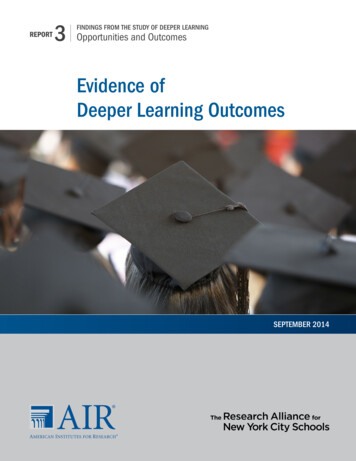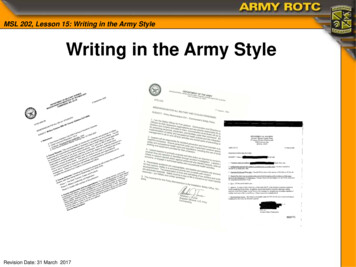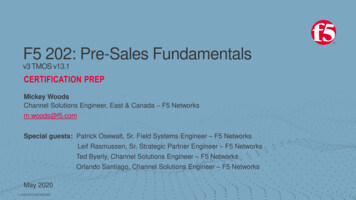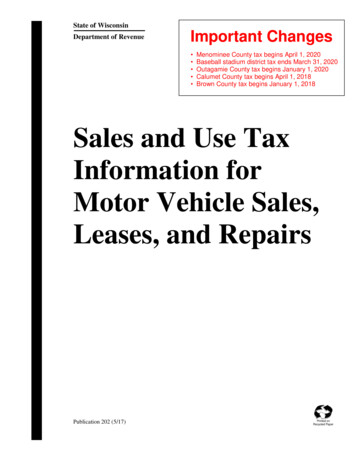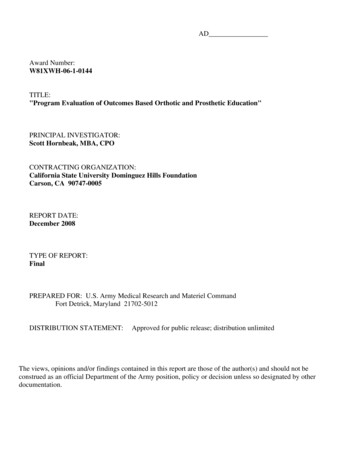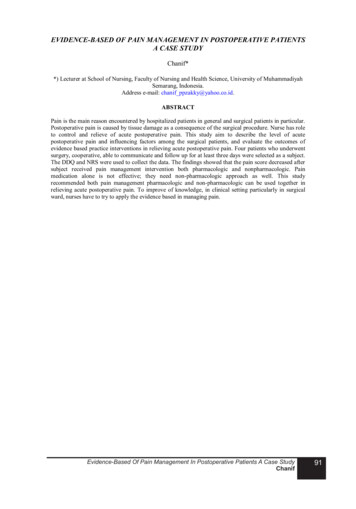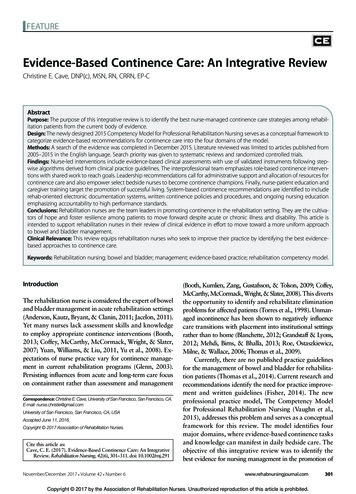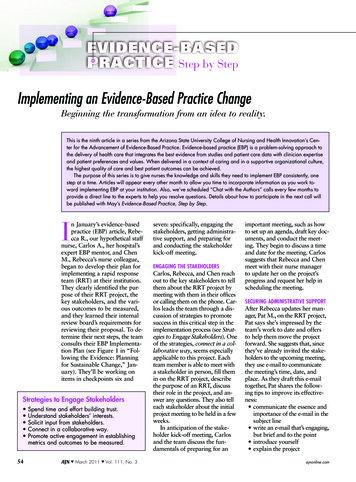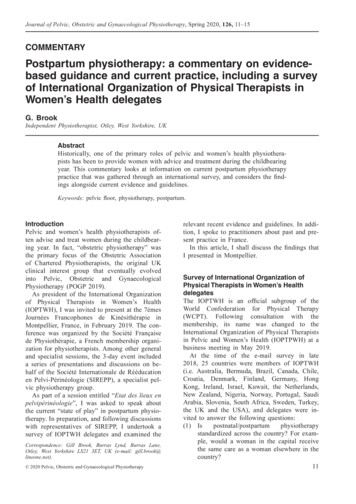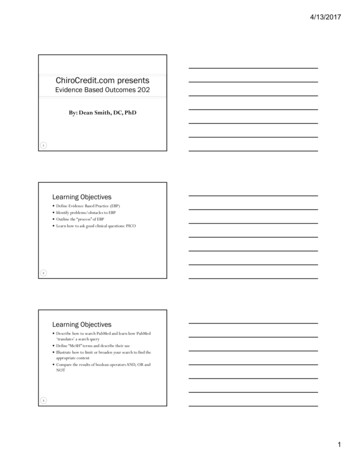
Transcription
4/13/2017ChiroCredit.com presentsEvidence Based Outcomes 202By: Dean Smith, DC, PhD1Learning Objectives Define Evidence Based Practice (EBP) Identify problems/obstacles to EBP Outline the “process” of EBP Learn how to ask good clinical questions: PICO2Learning Objectives Describe how to search PubMed and learn how PubMed‘translates’ a search query Define “MeSH” terms and describe their use Illustrate how to limit or broaden your search to find theappropriate content Compare the results of boolean operators AND, OR andNOT31
4/13/2017Evidence Based Practice Integration of clinical expertise with the patient’s values andthe best available research evidence to ensure optimaloutcomes Becoming proficient with this process takes time andconsistent practice, but should ultimately lead to improvedpatient outcomes4The Problems In a busy practice, doctors and therapists constantlyencounter patient care problems for which they have noimmediate answer Health practitioners require a large amount of informationregarding diagnosis, prognosis, therapy, and prevention on adaily basis5The Problems With the exception of using textbooks to answer basicanatomy, physiology, or pathology questions, traditionalsources of information are usually inadequate because theyare either incorrect, ineffective, outdated, or too voluminousto be practical6Virgilio RF, Chiapa AL, Palmarozzi EA. Evidence-based medicine, part 1. An introduction to creating an answerable question andsearching the evidence. J Am Osteopath Assoc. 2007 Aug;107(8):295-7.2
4/13/2017The Problems With experience, practitioners rely less on their formaltraining As judgment and diagnostic skills improve, knowledge ofcurrent diseases and treatment often declines Busy practitioners, often do not have time to search for up-to-date information7Virgilio RF, Chiapa AL, Palmarozzi EA. Evidence-based medicine, part 1. An introduction to creating an answerable question andsearching the evidence. J Am Osteopath Assoc. 2007 Aug;107(8):295-7.893
4/13/2017The Irony Many practitioners believe that practicing EBP requires toomuch time; but, in reality, a purpose of EBP is to improveefficiency in clinical decision making and to assist us inselecting and applying interventions that will maximizepositive patient outcomes10Cleland JA, Noteboom JT, Whitman JM, Allison SC. A primer on selected aspects of evidence-based practice relating to questions oftreatment. Part 1: asking questions, finding evidence, and determining validity. J Orthop Sports Phys Ther. 2008 Aug;38(8):476-84.Is Evidence Based Practice Important? Chiropractors and massage therapists acknowledge theimportance of research to validate their practice but havelittle confidence in their research skills and overallapplication of research in practice was limited Neither chiropractors nor massage therapistsconsistently apply research in practice, which may resultfrom a lack of research education and research skills11Suter E, Vanderheyden LC, Trojan LS, Verhoef MJ, Armitage GD. How important is research-based practice to chiropractors and massagetherapists? J Manipulative Physiol Ther. 2007 Feb;30(2):109-15.EBP Examples Recent example is the management of children who haveacute otitis media (AOM)1 There is good evidence from high-quality trialsconducted by chiropractic and other research groups thatspinal manipulation is as good as or better than a broadrange of treatments for the care of LBP, NP, and certainheadache types2121Miser WF. An introduction to evidence-based medicine. Prim Care. 2006 Dec;33(4):811-29.2Haas M, Bronfort G, Evans RL. Chiropractic clinical research: progress and recommendations. J Manipulative Physiol Ther. 2006 NovDec;29(9):695-706.4
4/13/2017The Questions In one study, family physicians most often had questionscenter around treatment (45%), diagnosis or evaluation (22%),etiology (4%), adverse effects of treatments or exposures (4%),epidemiology (4%), screening (3%), prognosis (3%), andprevention (2%)Alper BS, White DS, Ge B. Physicians answer more clinical questions and change clinical decisions more often with synthesized evidence:a randomized trial in primary care. Ann Fam Med 2005;3:507–13.13The EBP Processformulating an appropriate questionperforming an efficient literature search(3) critically appraising the best available evidence(4) applying the best evidence to clinical practice(5) assessing outcomes of care(1)(2)14Cleland JA, Noteboom JT, Whitman JM, Allison SC. A primer on selected aspects of evidence-based practice relating to questions oftreatment. Part 1: asking questions, finding evidence, and determining validity. J Orthop Sports Phys Ther. 2008 Aug;38(8):476-84.The EBP Process 15Becoming proficient with this process takes time andconsistent practice, but should ultimately lead to improvedpatient outcomesCleland JA, Noteboom JT, Whitman JM, Allison SC. A primer on selected aspects of evidence-based practice relating to questions oftreatment. Part 1: asking questions, finding evidence, and determining validity. J Orthop Sports Phys Ther. 2008 Aug;38(8):476-84.5
4/13/2017Develop a specific answerable questionfrom a clinical problem 16The first and often most difficult step is the developmentof a well-built clinical question that facilitates a literaturesearch, ultimately leading to the best evidence available toremove or optimally reduce clinical uncertaintyCleland JA, Noteboom JT, Whitman JM, Allison SC. A primer on selected aspects of evidence-based practice relating to questions oftreatment. Part 1: asking questions, finding evidence, and determining validity. J Orthop Sports Phys Ther. 2008 Aug;38(8):476-84.Two Types of Questions: Background andForeground 17Background questions are developed to enhanceknowledge relative to a specific disorder. For example, aclinician may ask “What causes carpal tunnel syndrome?”or “Why do patients develop coronary artery disease?”Cleland JA, Noteboom JT, Whitman JM, Allison SC. A primer on selected aspects of evidence-based practice relating to questions oftreatment. Part 1: asking questions, finding evidence, and determining validity. J Orthop Sports Phys Ther. 2008 Aug;38(8):476-84.Two Types of Questions: Background andForeground 18Foreground questions ask for specific information tomake clinical decisions or take immediate actionDeveloped in response to the need to identify evidenceregarding the use of a specific intervention in themanagement of a particular patientCleland JA, Noteboom JT, Whitman JM, Allison SC. A primer on selected aspects of evidence-based practice relating to questions oftreatment. Part 1: asking questions, finding evidence, and determining validity. J Orthop Sports Phys Ther. 2008 Aug;38(8):476-84.6
4/13/2017Foreground and PICO 19Foreground questions of therapy consist of 4 components:(1) a patient or problem(2) an intervention(3) a comparison intervention (if relevant)(4) an outcomeCleland JA, Noteboom JT, Whitman JM, Allison SC. A primer on selected aspects of evidence-based practice relating to questions oftreatment. Part 1: asking questions, finding evidence, and determining validity. J Orthop Sports Phys Ther. 2008 Aug;38(8):476-84.P - Patient Who is the patient, such as her age and history (eg, Is this herfirst episode of back pain, or is it chronic?)Is the pain caused by trauma (eg whiplash) and what is thisspecific problem (2 days after MVA or 2 years after MVA)?Miser WF. An introduction to evidence-based medicine. Prim Care. 2006 Dec;33(4):811-29.20I - Intervention Should the clinician begin with mobilization of the backimmediately after an MVA?Passive modalities?Miser WF. An introduction to evidence-based medicine. Prim Care. 2006 Dec;33(4):811-29.217
4/13/2017C – Comparison Intervention Should the clinician follow an alternate treatment approachsuch as a wait-and-see approach?Is manipulation better than mobilization immediatelyfollowing an MVA?Miser WF. An introduction to evidence-based medicine. Prim Care. 2006 Dec;33(4):811-29.22O – Outcomes What are the outcomes that are considered important for thispatient and problem (eg, reduction in symptoms andrestoration of function; preventing chronicity; preventcomplications such as disuse/deconditioningMiser WF. An introduction to evidence-based medicine. Prim Care. 2006 Dec;33(4):811-29.23Putting PICO together 24In a 38-year-old female with carpal tunnel syndrome,what is the efficacy of exercise and ergonomicinterventions compared to no treatment for decreasingpain and disability?Cleland JA, Noteboom JT, Whitman JM, Allison SC. A primer on selected aspects of evidence-based practice relating to questions oftreatment. Part 1: asking questions, finding evidence, and determining validity. J Orthop Sports Phys Ther. 2008 Aug;38(8):476-84.8
4/13/2017Rice MJ. Evidence-based practice problems: form and focus. J Am Psychiatr Nurses Assoc. 2010Sep;16(5):307-14.25Search the best evidence that answersyour question Once the question has been formulated, the next step isto search for relevant evidence that will help to answerthat questionSearching for the evidence efficiently is important,because practitioners do not have much timeMiser WF. An introduction to evidence-based medicine. Prim Care. 2006 Dec;33(4):811-29.26279
4/13/2017Consult Primary and Secondary Sources Primary sources such as research articles are good to findspecific information on a topic and are the ‘real’ sourcesof evidenceSecondary sources of evidence include reviews on topicsand can be extremely useful for the busy clinician (e.g.,review articles)28What is PubMed? Search interface from the U.S. National Library ofMedicine (NLM). Covers the fields of medicine, nursing, dentistry,pharmacy, and others areas of the life sciences. Provides access to millions of citations in MEDLINE,PreMEDLINE, and other related databases Citations from the 1950s to the present are searchable inPubMed Starting a search1. Go to http://www.pubmed.com29Keyword or phrase searching To perform a search, click in the search box and enter akeyword or phrase related to your topic. Multiple termswill automatically be combined with AND. For phrasesearching, use quotations (e.g. “chiropractic adjustment”). Inthis example, type in chiropractic adjustment and pressgo. 2. Press the enter key or click on the Search button tobegin and view your results.3010
4/13/201731Mapping term to subject headingAutomatic term mapping 1. PubMed automatically takes your keywords or phrasesand interprets them as subject headings used by thedatabase. These words are matched (in this order) againsta MeSH (Medical Subject Headings) Translation Table, aJournals Translation Table, and an Author Index. 2. Click on the Details button to verify how your termswere translated and to edit your search strategy.3233Click here for the details - given the phrase chiropractic adjustment11
4/13/201734This is how pubmed translates your phrase chiropractic adjustmentMeSH Database 1. Click on the MeSH Database link using the dropdownmenu under PubMed just left of the search box. 2. To look up the correct MeSH term, enter your first termin the search box. 3. PubMed will check your term against the MeSH mappingsand display the associated MeSH term(s).35MeSH Database 4. Click on the appropriate MeSH term for your topic;from this screen you can attach subheadings and/orrestrict terms to a MeSH Major Topic. 5. PubMed will automatically explode your MeSH term(i.e. pick up all related narrower terms). To deselect,click in the check box provided. 6. To locate citations to articles on your topic, selectSearch box with AND 7. The MeSH term for your topic will appear in thesearch box. Then click on Search PubMed.3612
4/13/2017MeSH term for chiropracticadjustmentTutorial37If you type in ‘chiropractic adjustment’ PubMed suggests ‘Manipulation, Chiropractic’ theclosest associated term to search. The MeSH database also displays where the termfits in the MeSH tree, a hierarchical structure of broader and narrower terms.Combining two or more termsBoolean logic1. Use AND to retrieve all of the terms: e.g. chiropractic andspinal manipulation.2. Use OR to retrieve any of the terms: e.g. chiropractic orspinal manipulation.3. Use NOT to eliminate terms: e.g. chiropractic not spinalmanipulation.38The operator ‘AND’ is used to retrieve citations that contain all the searchterms. It narrows the search to be more precise.3913
4/13/2017The operator ‘OR’ is used to retrieve citations that contain all thesearch terms. Using OR broadens the search.40The operator ‘NOT’ is used to restrict citations containing a particularsearch term. Using NOT eliminates items.41Combining two or more termsBoolean logic4. To search a complex topic, enclose an individual concept inPARENTHESES. The terms inside the parentheses will beprocessed as a unit and then incorporated into the overallstrategy e.g. neck pain and (chiropractic or spinal manipulation)4214
4/13/201743You can also combine separate searches: After performing your searches, click on Advanced(just below search bar). To combine searches, use # before the set number (e.g. #7 and #10).44Filtering (Limiting) a searchSpecifying results1. After entering your search terms, view the options in theleft sidebar.2. Select as many limits as you want by choosing from theshow additional filters (e.g. age group, languages, gender,human or animal studies, publication types, etc.).4515
4/13/201746Limiting a searchSpecifying results3. Click on the items you would like to filter by.4. A check mark will appear beside to the item to indicatethat this feature is in use.47Displaying and marking search resultsViewing complete records:1. PubMed automatically displays your search results in a Summaryformat (author, title, and journal information). To view the abstract foran individual record, click on the title of the article.2. To change the format of your search results, choose from the dropdown menu of Format (e.g. abstract, summary, etc.).3.You can also increase the number of records displayed on each pageby choosing Per Page.4816
4/13/2017Abstract ViewLink(s) to full text article49Using the clipboard1.The clipboard allows you to temporarily save or viewselected citations from one search or several searches.2. To place item(s) on the clipboard, click on the checkbox(es) to the left of the citations.3. Click on the Send To drop-down menu, and chooseClipboard.50Using the clipboard4. Once you have added a citation to the clipboard, therecord number colour will change to green.5. To view the contents of your clipboard, click on theClipboard items just to the right of Send to.5117
4/13/2017Send to clipboard52View the clipboard53Printing, saving or emailing citations Clipboard items or current search set1.You can print, save, or email items from either the clipboard orfrom the current search set.2. Format the clipboard items or current search set using theFormat dropdown.5418
4/13/2017Clicking send to filewill prompt a pop-updownload text window55Emailing Your Search Results Your PubMed e-mail message displays as a PubMed resultspage and includes hyperlinks to Related Articles and otherPubMed features. But, your e-mail program must be set forHTML view in order to properly view the message.56PICO Interface5719
4/13/2017Clinical Queries58Index to Chiropractic Literaturewww.chiroindex.org5920
regarding diagnosis, prognosis, therapy, and prevention on a . Chiropractors and massage therapists acknowledge the . database These . words are matc hed (in this order) against a MeSH (Medical Subject Headings) Translation
